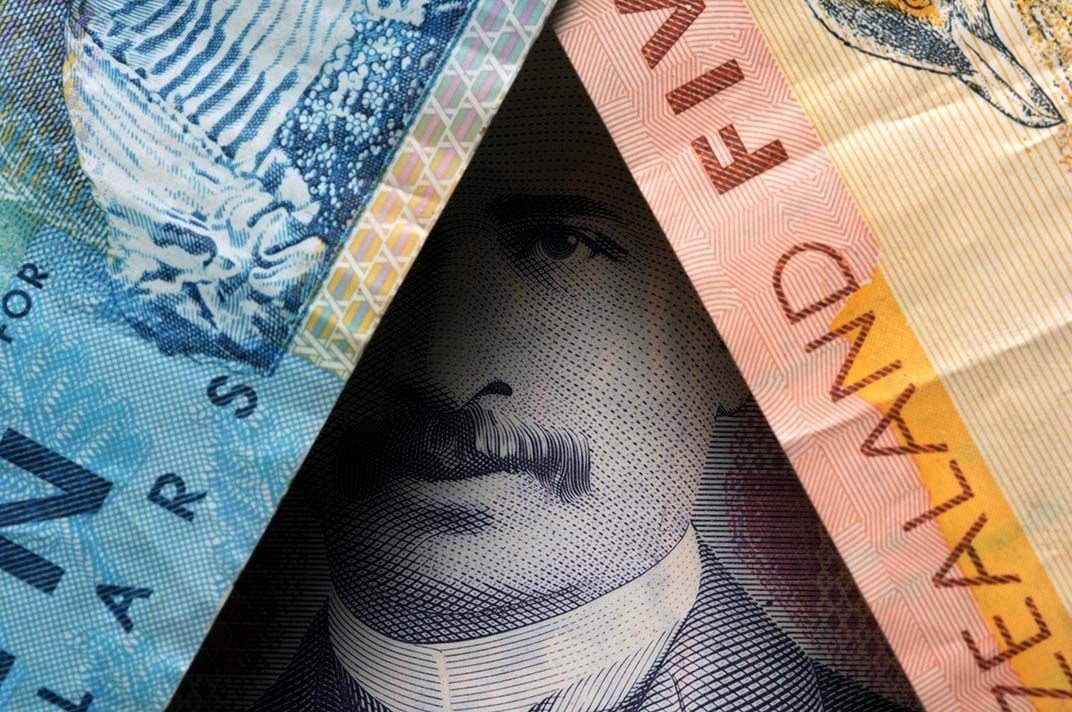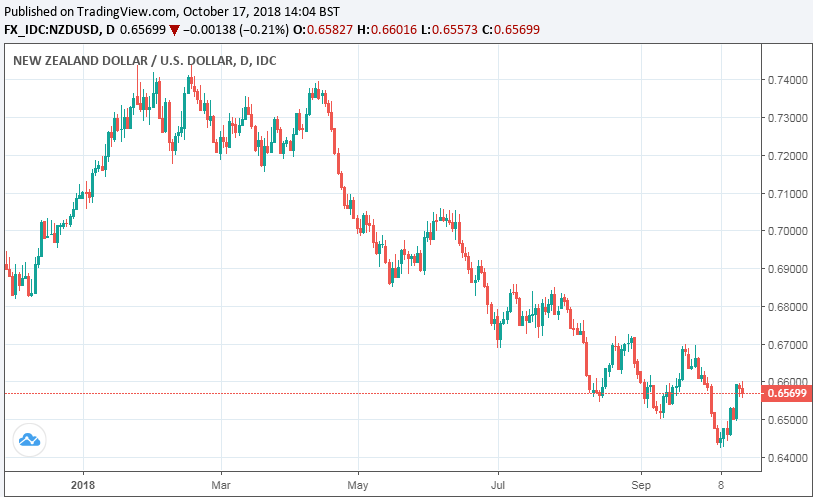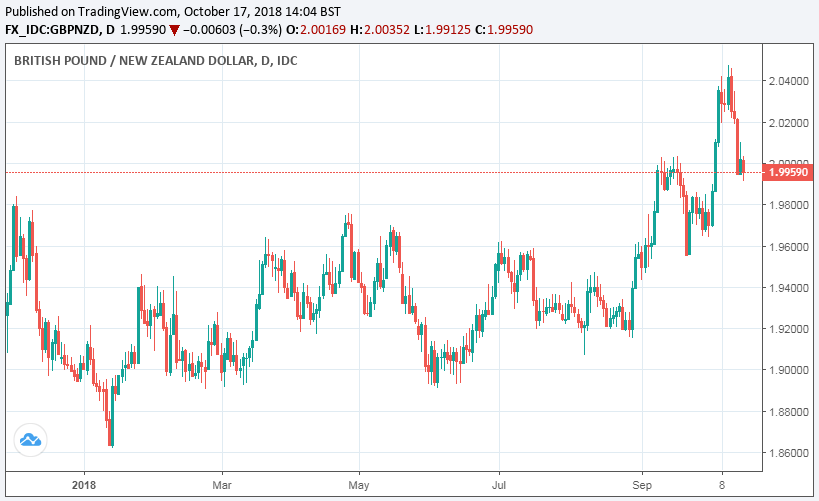The New Zealand Dollar has a Long Way to Go before it's Out of the Woods says NAB
- Written by: James Skinner

© Comugnero Silvana, Adobe Stock
- NZD's October bounce was likely driven by short-covering says NAB.
- Kiwi has a long way to go, well into 2019, before it's out of the woods.
- NZD/USD to recover in 2019, GBP/NZD faces losses before year-end.
The New Zealand Dollar has staged a determined comeback from multi-year lows in recent weeks but it still has a long way to go before the downtrend gripping the Antipodean currency is broken, according to strategists at National Australia Bank (NAB).
New Zealand's currency has risen close to 2% against the U.S. Dollar this last week, up from the 0.6424 nadir seen on October 10 that marked the NZD/USD rate's lowest level since February 2016. This helped drag the Pound-to-New-Zealand-Dollar rate down from 2.0450 to 1.9964.
However, the Kiwi is still carrying a 7.2% loss against the U.S. Dollar and a 5% decline against Sterling for 2018. Moreover, the factors that have driven that decline, including a near-hopeless outlook for interest rates and President Donald Trump's "trade war" against China, are still as relevant as ever for financial markets.
"To the extent that technical factors might be in play behind recent NZD support, it might be too early to declare that the downtrend in the NZD is over. Trendline resistance sits around 0.6640 but we’d want to see a break of previous resistance at 0.6730 to be more confident that the downtrend has been broken," says Ray Attrill, head of FX strategy at NAB.

Above: NZD/USD rate shown at daily intervals.
New Zealand's Dollar has been blighted by a duo of headwinds in 2018, beginning with disappointmenting inflation and growth data that has driven a deterioration of the Kiwi interest rate outlook, and more recently an escalation of the so called trade war between the U.S. and China.
The inflation and growth outlook has been become so tepid the Reserve Bank of New Zealand (RBNZ) begun warning in July that it could cut interest rates over coming quarters if the economy does not pick up sufficiently to support a return of the consumer price index toward the upper end of the 1% to 3% target band.
Coming amid President Donald Trump's trade war with New Zealand's largest customer for its chief exports of agricultural goods, China, speculators have bet heavily against the Kiwi Dollar in 2018. So much so that the amount of money now stacked against the Kiwi is close to a record high.
"The NZD’s outperformance over the past week seems like a perverse performance in light of a significant correction in global equity markets and our risk appetite index plunging from 64% to 51%. But the big risk-off move, centred in equity markets, likely triggered some short covering of positions across a range of assets and CFTC data has shown, for some time, large short positioning in the NZD," says Atttrill.
Attrill argues the Kiwi's October bounce looks, at the moment at least, as if it is little more than the result of traders taking profits off the table. In order for "short sellers" to crystalise profits they must first buy back the New Zealand Dollar, after having sold it at an earlier date.

Above: Pound-to-New-Zealand-Dollar rate shown at daily intervals.
In order for the Antipodean currency to embark upon a sustainable turnaround, either the domestic inflation outlook needs to improve, the trade war would have to be de-escalated or the U.S. Dollar would need to go into retreat.
The greenback remains on its front foot while U.S. and Chinese negotiators are yet to make any meaningful progress in resolving their differences, but third-quarter inflation data offered the market a glimmer of hope this week.
"The inflation data follows much stronger Q2 GDP data than the RBNZ expected and other activity data holding up nicely," Attrill notes, in NAB's latest review of currency markets. "Inflation is expected to move higher and spend some time well above the 2% mark. This should ultimately change the balance of risks the RBNZ sees on policy and as time passes we see the market pricing out the current modest easing pricing into the OIS curve."
Markets care about the inflation data because it has a direct bearing on Reserve Bank of New Zealand interest rate policy.
Changes in interest rates are only made in response to movements in inflation but impact currencies because of the push and pull influence they have on international capital flows and their allure for short-term speculators.
The RBNZ has held its interest rate at its current record low of 1.75% ever since the end of 2016, citing weak wage growth and an outlook for the economy that are both placing attainment of its inflation target in jeopardy.
"Let’s be clear, NZ rates are below USD rates across the whole curve and are a headwind for the NZD, but at some point a less dovish RBNZ might be expected to offer some NZD support," says Attrill.
Forecasts: 2019 Recovery in Sight
Attrill and the NAB team's forecasts suggest the NZD/USD rate will remain depressed around the 0.65 area for the rest of 2018 but that the Pound-to-New-Zealand-Dollar rate will ease back from 2.02 to 1.96 by year-end.
Howver, they project that an improvement in the interest rate outlook will lift the NZD/USD rate to 0.69 before the end of 2019 but that the Pound-to-Kiwi rate will then rise back to 2.04.
The NZD/USD rate was quoted 0.23% lower at 0.6566 Wednesday although the Pound-to-New-Zealand-Dollar rate was down 0.35% at 1.9962.
Advertisement
Get up to 5% more foreign exchange by using a specialist provider to get closer to the real market rate and avoid the gaping spreads charged by your bank when providing currency. Learn more here




